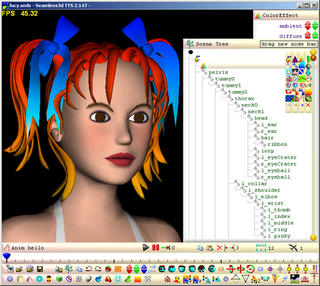
Adobe Flash is a discontinued multimedia software platform used for production of animations, rich internet applications, desktop applications, mobile apps, mobile games, and embedded web browser video players.
X3D is a set of royalty-free ISO/IEC standards for declaratively representing 3D computer graphics. X3D includes multiple graphics file formats, programming-language API definitions, and run-time specifications for both delivery and integration of interactive network-capable 3D data. X3D version 4.0 has been approved by Web3D Consortium, and is under final review by ISO/IEC as a revised International Standard (IS).
This comparison of free software for audio lists notable free and open source software for use by sound engineers, audio producers, and those involved in sound recording and reproduction.
An application program is a computer program designed to carry out a specific task other than one relating to the operation of the computer itself, typically to be used by end-users. Word processors, media players, and accounting software are examples. The collective noun "application software" refers to all applications collectively. The other principal classifications of software are system software, relating to the operation of the computer, and utility software ("utilities").

Fast Light Toolkit (FLTK) is a cross-platform widget library for graphical user interfaces (GUIs), developed by Bill Spitzak and others. Made to accommodate 3D graphics programming, it has an interface to OpenGL, but it is also suitable for general GUI programming.

Open Cascade Technology (OCCT), formerly called CAS.CADE, is an open-source software development platform for 3D CAD, CAM, CAE, etc. that is developed and supported by Open Cascade SAS company.
BioVision Hierarchy (BVH) is a file format used for storing motion capture data. It was developed by BioVision, a company that was later acquired by Motion Analysis Corporation. The format consists of a hierarchical structure of joints, with each joint containing rotation and translation data. BVH files are widely used in the film, gaming, and animation industries.

Seamless3d is an open-source 3D modeling software available under the MIT license.

Antics3D was a real-time 3D animation software program published by Antics Technologies. It is used by amateurs and professionals to create 3-dimensional, animated visualisations of events in a variety of industries. Filmmakers form the largest userbase, who use the software for pre-vizualisation, storyboarding and machinima. However, the software is also used in forensic animation, education, training and many other areas which benefit from animated visualisations. The user interface in Antics3D, which is significantly easier than in traditional animation software, has in large part contributed to its uptake in these sectors that lack animation expertise.
The following outline is provided as an overview of and topical guide to software:
iClone is a real-time 3D animation and rendering software program. Real-time playback is enabled by using a 3D videogame engine for instant on-screen rendering.

OpenQwaq is open source computer software for immersive collaboration, which enables organizations to implement online 3D virtual world workspaces for their specific needs. OpenQwaq is based on the Teleplace technology, a conferencing platform that has been in the market since 2007, with the name Qwaq Forums until 2009.
Toonz is a 2D animation software program. The base application is currently managed by Dwango as open-source software under the name OpenToonz. An extended commercial variant for professional individuals and studios, Toonz Premium, is being developed and marketed by Digital Video S.p.A. Toonz has been used by studios such as Studio Ghibli and Rough Draft Studios.
Blend4Web is a free and open source framework for creating and displaying interactive 3D computer graphics in web browsers.





